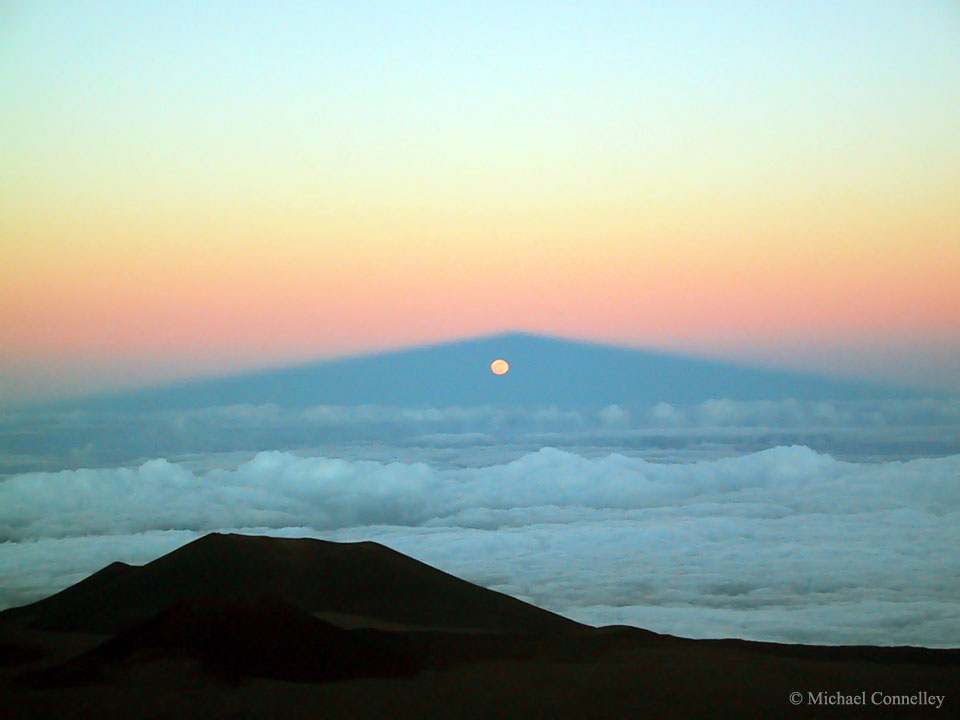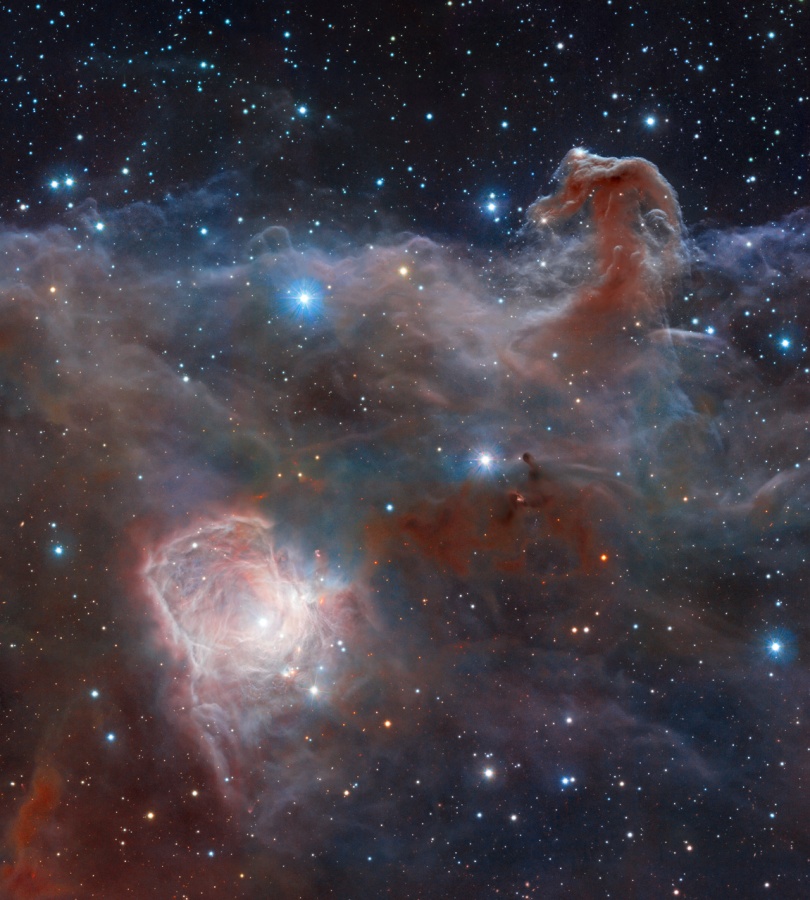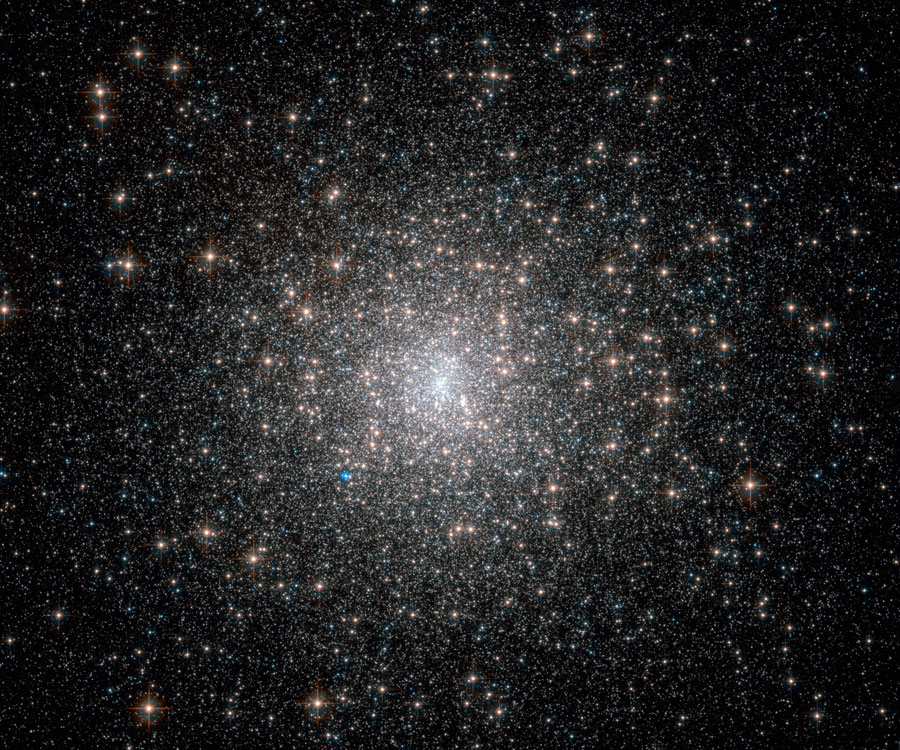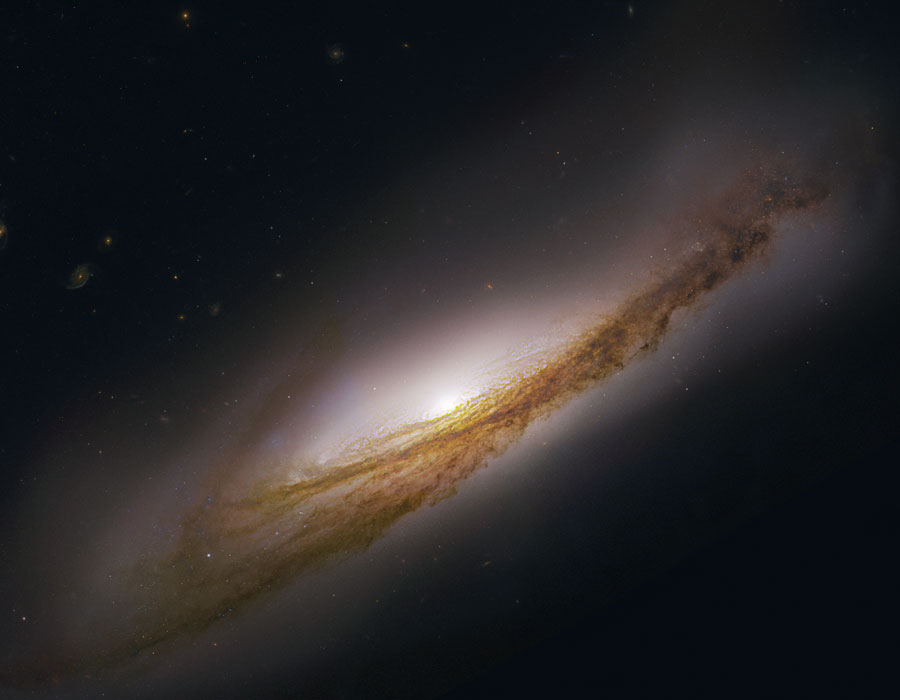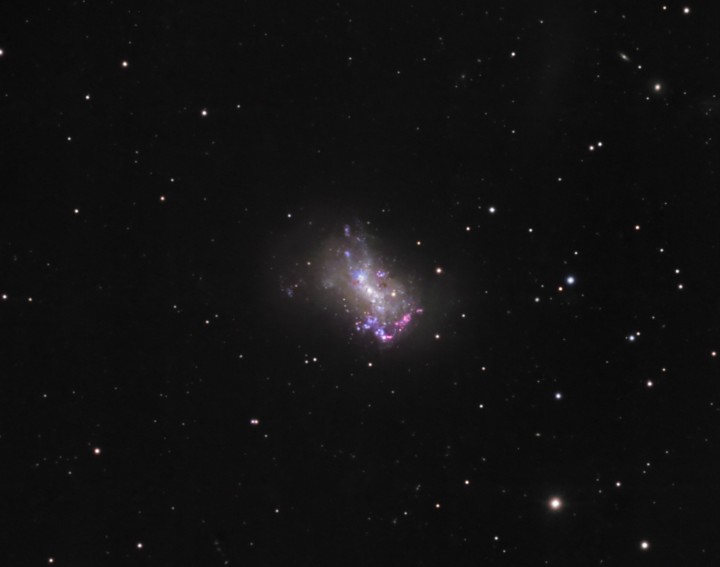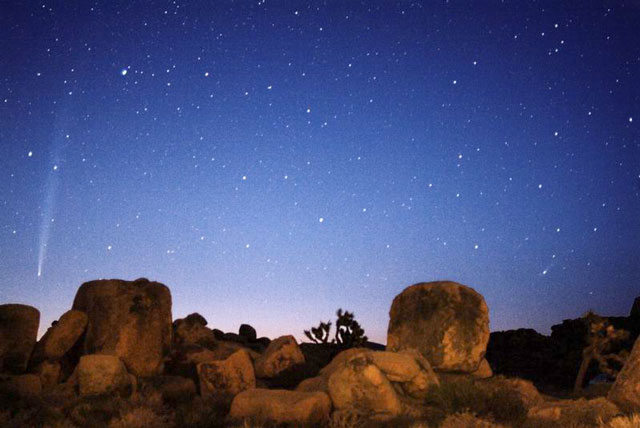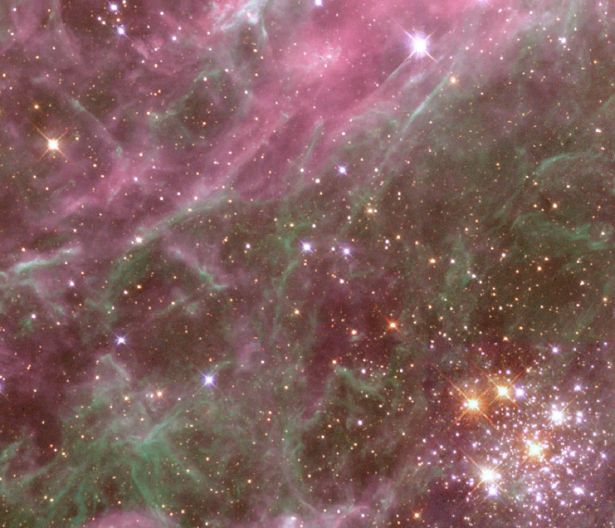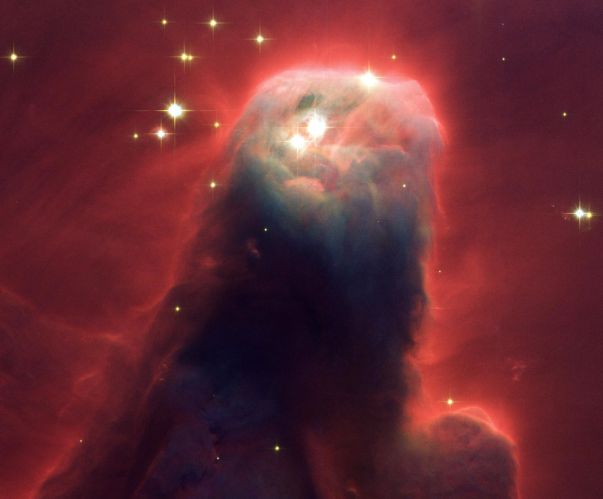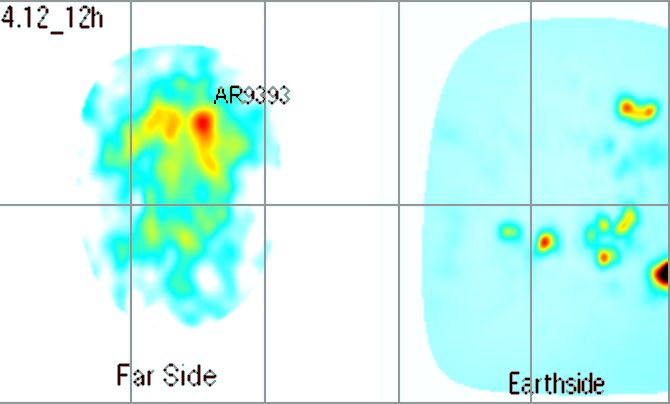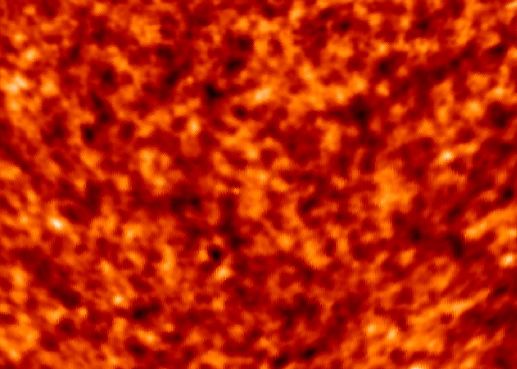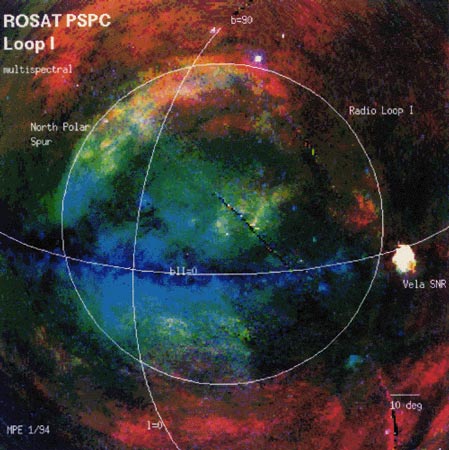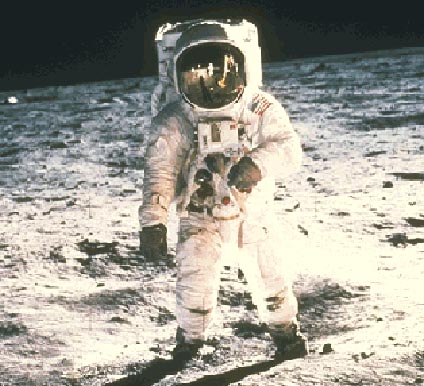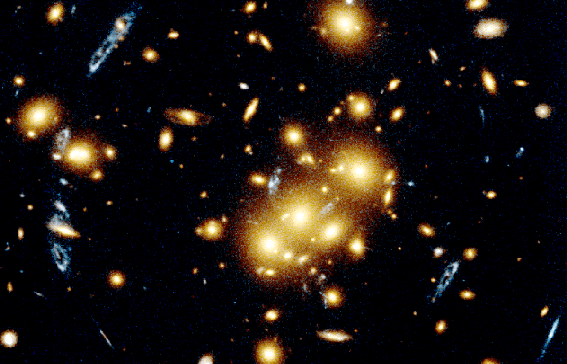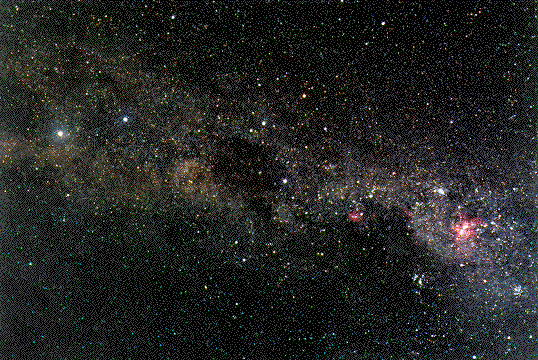| << Previous | Index | Next >> |
2015 How can the Moon rise through a mountain? It cannot -- what was photographed here is a moonrise through the shadow of a large volcano. The volcano is Mauna Kea, Hawai'i, USA, a frequent spot for spectacular photographs since it is arguably the premier observing location on planet Earth. The Sun has just set in the opposite direction, behind the camera. Additionally, the Moon has just passed full phase -- were it precisely at full phase it would rise, possibly eclipsed, at the very peak of the shadow. The Moon is actually rising in the triangular shadow cone of the volcano, a corridor of darkness that tapers off in the distance like converging train tracks. The Moon is too large and too far away to be affected by the shadow of the volcano. Refraction of moonlight through the Earth's atmosphere makes the Moon appear slightly oval. Cinder cones from old volcanic eruptions are visible in the foreground.
2014 The yellowish star near center in this dusty telescopic skyview is T Tauri, prototype of the class of T Tauri variable stars. Just next door is the yellow cosmic cloud historically known as Hind's Variable Nebula (NGC 1555). Over 400 light-years away, at the edge of an otherwise invisible molecular cloud, both star and nebula are seen to vary significantly in brightness but not necessarily at the same time, adding to the mystery of the intriguing region. T Tauri stars are now generally recognized as young (less than a few million years old), sun-like stars still in the early stages of formation. To further complicate the picture, infrared observations indicate that T Tauri itself is part of a multiple system and suggest that the associated Hind's Nebula may also contain a very young stellar object. The naturally colored image spans about 7 light-years at the estimated distance of T Tauri.
2013
2012
2011 Stars, like bees, swarm around the center of bright globular cluster M15. This ball of over 100,000 stars is a relic from the early years of our Galaxy, and continues to orbit the Milky Way's center. M15, one of about 150 globular clusters remaining, is noted for being easily visible with only binoculars, having at its center one of the densest concentrations of stars known, and containing a high abundance of variable stars and pulsars. This sharp image, taken by the Earth-orbiting Hubble Space Telescope, spans about 120 light years. It shows the dramatic increase in density of stars toward the cluster's center. M15 lies about 35,000 light years away toward the constellation of the Winged Horse (Pegasus). Recent evidence indicates that a massive black hole might reside as the center of M15.
2010 Some spiral galaxies are seen almost sideways. NGC 3190, one such galaxy, is the largest member of the Hickson 44 Group, one of the nearer groups of galaxies to our own Local Group of galaxies. Pictured above, finely textured dust lanes surround the brightly glowing center of this picturesque spiral. Gravitational tidal interactions with other members of its group have likely caused the spiral arms of NGC 3190 to appear asymmetric around the center, while the galactic disk also appears warped. NGC 3190 spans about 75,000 light years across and is visible with a small telescope toward the constellation of the Lion (Leo).
2009 In 1787, astronomer William Herschel discovered the Eskimo Nebula. From the ground, NGC 2392 resembles a person's head surrounded by a parka hood. In 2000, the Hubble Space Telescope imaged the Eskimo Nebula. From space, the nebula displays gas clouds so complex they are not fully understood. The Eskimo Nebula is clearly a planetary nebula, and the gas seen above composed the outer layers of a Sun-like star only 10,000 years ago. The inner filaments visible above are being ejected by strong wind of particles from the central star. The outer disk contains unusual light-year long orange filaments. The Eskimo Nebula spans about 1/3 of a light year and lies in our Milky Way Galaxy, about 3,000 light years distant, toward the constellation of the Twins (Gemini).
2008 Snow-capped stratovolcano Mt. Damavand climbs to 5,670 meters (18,598 feet) near the left edge in this panoramic view of the world at night. In the sky to the left of Damavand's peak are the stars of the Big Dipper in Ursa Major. Pan to the right and your gaze will sweep across the arch of our Milky Way Galaxy above the Alborz Mountain Range bordering the Caspian Sea. Near the center of the panorama, recorded in the predawn hours of April 4th, bright stars Deneb and Altair lie close to the curve of the Milky Way, above the glow of the Haraz valley. Farther right, brilliant Jupiter dominates the sky near the stars, nebulae, and dark dust clouds toward the bulging galactic center. Finally, the horizon glow at the right edge, below bright yellowish giant star Antares, is from the city of Damavand, named for the legendary mountain peak.
2007 Grand spiral galaxies often seem to get all the glory. Their newly formed, bright, blue star clusters along beautiful, symmetric spiral arms are guaranteed to attract attention. But small irregular galaxies form stars too, like NGC 4449, located about 12 million light-years away. The well-studied galaxy is similar in size, and often compared to our Milky Way's satellite galaxy, the Large Magellanic Cloud (LMC). This lovely color image shows NGC 4449's general bar shape, also characteristic of the LMC, with scattered young blue star clusters. Near the bottom is the pinkish glow of atomic hydrogen gas, the telltale tracer of massive star forming regions. NGC 4449 is a member of a group of galaxies found in the constellation Canes Venatici. In fact, interactions with nearby galaxies are thought to have influenced star formation in NGC 4449.
2006 Why is Saturn partly blue? The above picture of Saturn approximates what a human would see if hovering close to the giant ringed world. The above picture was taken in mid-March by the robot Cassini spacecraft now orbiting Saturn. Here Saturn's majestic rings appear directly only as a thin vertical line. The rings show their complex structure in the dark shadows they create on the image left. Saturn's fountain moon Enceladus, only about 500 kilometers across, is seen as the bump in the plane of the rings. The northern hemisphere of Saturn can appear partly blue for the same reason that Earth's skies can appear blue -- molecules in the cloudless portions of both planet's atmospheres are better at scattering blue light than red. When looking deep into Saturn's clouds, however, the natural gold hue of Saturn's clouds becomes dominant. It is not known why southern Saturn does not show the same blue hue -- one hypothesis holds that clouds are higher there. It is also not known why Saturn's clouds are colored gold.
2005 If you wait long enough, the entire Solar System will rise before you. To see such a sight, however, you will need to look in the direction of the ecliptic. All of the planets and their moons orbit the Sun in nearly the same plane, the ecliptic plane. From the Earth, this means that each day they will all rise in nearly the same direction - and later set in the opposite direction. Ten years ago, a series of time exposures caught, left to right, the Sun, Venus, the Moon, and Jupiter, all rising in the ecliptic plane behind Fire Island, New York, USA. Exposures were taken every six minutes and digitally superposed on an image taken from the same location at sunrise. Smaller members of our Solar System, including most comets and many asteroids, do not always move along the ecliptic plane. The picturesque Fire Island Lighthouse, visible in the foreground, was built in 1826 and is still in use today.
2004 Comet Bradfield is easy to see on the left, but can you find Comet LINEAR on the right? Last week, just before sunrise from the northern hemisphere, two bright comets were visible in the same part of the sky at the same time. The above long-exposure image was taken on the morning of April 25 from Joshua Tree National Park in California, USA. Comet C/2004 F4 (Bradfield) is giving an unexpectedly good show as it recedes from the Sun and Earth and fades from view. Its tail is estimated by some to be about 10 degrees long. Having just rounded the Sun itself, Comet C/2002 T7 (LINEAR) is now moving toward the Earth. Although intrinsically fading, T7 will appear to brighten until about mid-May and so continue to be visible to the unaided eye before sunrise to southern hemisphere observers into June. Q4, the third coincidental naked eye comet, will become visible in mid-May to northern hemisphere observers.
2003 The star cluster at lower right, cataloged as Hodge 301, is a denizen of the Tarantula Nebula. An evocative nebula in the southern sky, the sprawling cosmic Tarantula is an energetic star forming region some 168,000 light-years distant in our neighboring galaxy the Large Magellanic Cloud. The stars within Hodge 301 formed together tens of millions of years ago and as the massive ones quickly exhaust their nuclear fuel they explode. In fact, the giant stars of Hodge 301 are rapidly approaching this violent final phase of stellar evolution - known as a supernova. These supernova blasts send material and shock waves back into the nebular gas to create the Tarantula's glowing filaments also visible in this Hubble Space Telescope Heritage image. But these spectacular stellar death explosions signal star birth as well, as the blast waves condense gas and dust to ultimately form the next generation of stars inside the Tarantula Nebula.
2002 Cones, pillars, and majestic flowing shapes abound in stellar nurseries where natal clouds of gas and dust are buffeted by energetic winds from newborn stars. A well-known example, the Cone Nebula within the bright galactic star-forming region NGC 2264, was captured in this close-up view from the Hubble Space Telescope's newest camera. While the Cone Nebula, about 2,500 light-years away in Monoceros, is around 7 light-years long, the region pictured here surrounding the cone's blunted head is a mere 2.5 light-years across. In our neck of the galaxy that distance is just over half way from the Sun to its nearest stellar neighbor, Alpha Centauri. The massive star NGC 2264 IRS, seen by Hubble's infrared camera in 1997, is the likely source of the wind sculpting the Cone Nebula and lies off the top of the image. The Cone Nebula's reddish veil is produced by glowing hydrogen gas.
2001 You may think it's impossible to see through the Sun, but maps of the Sun's far side are now made routinely by instruments on board the sun-staring SOHO spacecraft. This is one such map from April 12. At right, is a map projection of calculated magnetic field strengths on the Earth-facing solar hemisphere with yellow and red indicating high magnetic fields characteristic of solar active regions. At left is a similar map of the solar hemisphere opposite planet Earth, which shows the large active region AR9393 as the 27-day solar rotation carried it across the far side. The largest sunspot group in a decade, AR9393 was easily seen as it tracked across the Sun's Earth-facing hemisphere in late March. When AR9393 swung around to the Sun's far side, SOHO's Michelson Doppler Interferometer (MDI) instrument continued to map its position by measuring changes in motions caused by solar sound waves - transmitted through the Sun and influenced by the active region's strong magnetic fields. Known as helioseismology, analyzing solar sound waves is like using seismological records of earthquakes to probe the interior of the Earth. On the Sun, sound waves are produced by turbulent convection cells seen on the surface as dynamic solar granules.
2000 Drifting through the stratosphere above Antarctica in late 1998, the balloon-borne BOOMERANG telescope peered into the cosmos at millimeter wavelengths. The blotchy structures it detected are seen above in the sharpest yet picture of the universe at an early age, perhaps a mere 300,000 years old. The false-color image shows subtle fluctuations in the temperature of the hot plasma which filled the universe before expansion cooled the material, producing the familiar stars and galaxies. Dramatically, the size of the fluctuations in the BOOMERANG image has convinced many cosmologists that the universe contains just exactly enough matter and energy to be flat -- a powerful prediction of the popular theory of Inflation which describes the earliest moments of the Big Bang. A flat universe will expand forever and two light rays which start out parallel will never spread or intersect. But all is not solved (!) as the BOOMERANG results don't show clearly details confirming the suspected amounts of dark matter and the cosmological constant.
1999 One of the largest coherent structures on the sky is known simply as Loop I and can best be seen in radio and X-ray maps. Spanning over 100 degrees, part of Loop I appears so prominent in northern sky maps that it is known as the North Polar Spur (NPS). Loop I, shown above in X-ray light, is a thin bubble of gas about 700 light-years across with a center located only about 400 light-years away. Surprisingly, the cause of this immense structure is still debated, but is possibly related to expanding gas from a million-year old supernova. Loop I gas is impacting the nearby Aquila Rift molecular cloud, and may create relatively dense fragments of the local interstellar medium. Were our Sun to pass through one of these fragments in the next few million years, it might affect Earth's climate.
1998 Humans once walked on the Moon. Pictured above is the second person to stand on the lunar surface: Edwin "Buzz" Aldrin. During this Apollo 11 mission, Neil Armstrong (the first person to walk on the moon) and Buzz Aldrin landed on the Moon while Michael Collins circled in the Command Module above. The lunar team erected a plaque on the surface that reads: HERE MEN FROM THE PLANET EARTH FIRST SET FOOT UPON THE MOON JULY 1969 A.D. WE CAME IN PEACE FOR ALL MANKIND. The Apollo missions demonstrated that it is possible to land humans on the Moon and return them safely.
1997 What are those strange blue objects? Many are images of a single, unusual, beaded, blue, ring-like galaxy which just happens to line-up behind a giant cluster of galaxies. Cluster galaxies here appear yellow and -- together with the cluster's dark matter -- act as a gravitational lens. A gravitational lens can create several images of background galaxies, analogous to the many points of light one would see while looking through a wine glass at a distant street light. The distinctive shape of this background galaxy -- which is probably just forming -- has allowed astronomers to deduce that it has separate images at 4, 8, 9 and 10 o'clock, from the center of the cluster. Possibly even the blue smudge just left of center is yet another image! This spectacular photo from HST was taken in October 1994. The first cluster lens was found unexpectedly by Roger Lynds (NOAO) and Vahe Petrosian (Stanford) in 1986 while testing a new type of imaging device. Lensed arcs around this cluster, CL0024+1654, were first discovered from the ground by David Koo (UCO Lick) in 1988.
1996 This breathtaking patch of sky would be above you were you to stand at the south pole of the Earth. Just above and to the right of the photograph's center are the four stars that mark the boundaries of the famous Southern Cross. At the top of this constellation, also known as "The Crux," is the orange star Gamma Crucis. The band of stars, dust, and gas crossing the middle of the photograph is part our Milky Way Galaxy. In the very center of the photograph is the dark Coal Sack Nebula, and the bright nebula on the far right is the Eta Carina Nebula. The southern cross is so famous a constellation that it is depicted on the Australian National Flag.
| << Previous | Index | Next >> |
